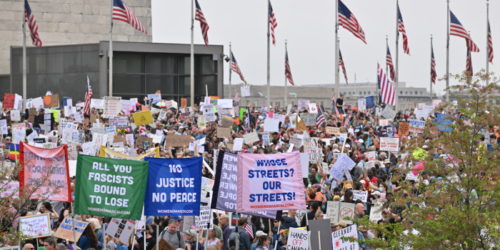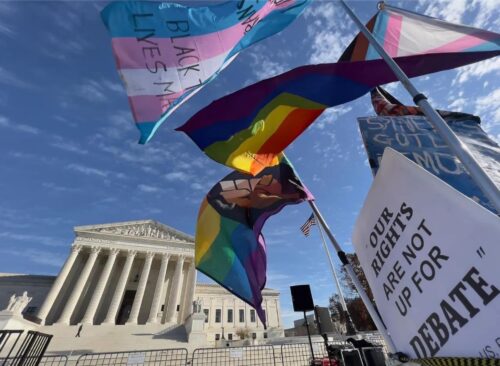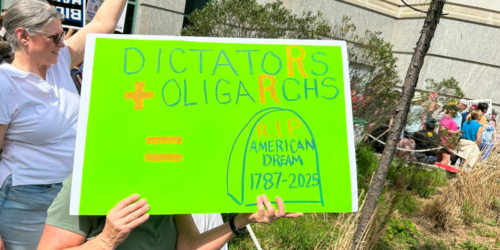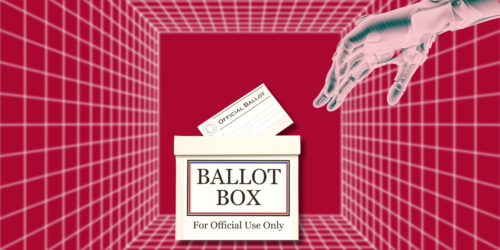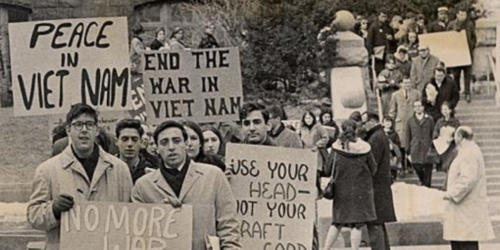Jay Ulfelder: You are listening to the Nonviolent Action Lab podcast. I’m your host, Jay Ulfelder. He/him together with Harvard Kennedy School Professor Erica Chenoweth, and other members of the Nonviolent Action Lab Team. Each episode we bring you the latest research, insights and ideas on how nonviolent action can or sometimes fails to transform injustice.
On May 2nd, 2022, Politico published Elite Draft Supreme Court opinion that would overturn Roe v. Wade and thereby reopened the door to abortion bans in the United States across the country. Activists immediately took to the streets in outrage in Washington dc Some of those activists soon settled into a weekly cycle of walks and demonstrations outside the homes of several Supreme Court justices that spanned a handful of area towns and ran for much of the rest of that year. Their demonstrations attracted national attention, spurring debates about the ethics of protesting outside public figures, homes, and drawing harsh condemnation from the right. In this episode, I talk with two of the people at the heart of those DC area actions about the what, how, and why of their protests and about the nature and intensity of the backlash they received.
Jay UIfelder: Can I ask you all to please introduce yourselves, including your preferred pronouns?
Nadine Seiler: Sadie could go first.
Rune: Hi. Yeah. My name is Rune. They/them, I go by Ro these days, but Sadie in the paper sometimes. Ro, they/them. And I’m with ORDC.
Jay UIfelder: Got you.
Nadine Seiler: Okay. My name is Nadine Seiler. I, she, her and I go by the Warrior goddess for the resistance.
Jay UIfelder: Yeah
Nadine Seiler: I claimed it. I didn’t name myself, but I claimed it.
Jay UIfelder: Yes.
So I think it was in May 20, 20, 22, after the Supreme Court’s draft ruling overturning Roe v. Wade leaked some DC area folks started marching to or past the homes of some Supreme Court justices to protest against that impending ruling. And those initial vigils and marches then evolved into a set of several weekly actions that took place near the homes of, I think it was five different justices, spread over four area towns and ran six. Okay. I was going to say, and ran for many months. And yeah, I wanted to ask, is that right? What did I get wrong there? And then I’m wondering if you all could tell us about how that evolved, how those weekly marches got started, and what your roles were in that process.
Nadine Seiler: Okay, so I’ll let run go first, but it were six justices over five. Five location.
Rune: Yeah. So yeah, it was six justices, to be clear. Gorsuch, Barrett, Kavanaugh, Roberts, Alito, Thomas, those were our six justices. Kavanaugh and Roberts live in the same neighborhoods, so they were always two for one. But yeah, over the course of, yeah, it was about five locations though. They were all in the same two counties, Fairfax County and Montgomery County. Just different areas. How we got started, I mean, basically personally, I was just showing up to the Supreme Court after the announcement of the Alito draft decision, and as were most of us who ended up meeting. So they had a couple of protests by shutdown dc, which was not organized by us, the first two protests at Kavanaugh and Alitos houses, and many of us attended those as well. But after those happened, we ended up in a group chat together, and Nadine especially, we really were like, we could keep doing this.
We could just keep doing this and we want to keep protesting. We want to keep speaking up about this situation. Especially we had time at the time, we had time before Roe was being overturned to at least gain support for abortion rights and hope that our protests could do something in that realm. And to be clear, we were never there to change the justice’s minds either. We knew very well we’re not going to change these people’s minds, and that law was brought up against us many times, but that was never our intention and we never made any demands of that kind. So it was really pushing, our main messaging was pushing Congress to do something as well as pushing people to stand up and speak up and show up for us and show up with us and for women and people birthing people across the country at the time.
Nadine Seiler: Okay. So I can add a little bit to it because I could be a little bit more detailed. I showed up at the Supreme Court on, I believe May would’ve been May 3rd. Cause I broke my phone the night before. The night the, that the decision came down. My phone had been giving me problems before that with reception issues, but the night that we got the decision was made, I got so angry about the decision, and then the phone started acting up. I literally took my phone and I threw it, not attempting to throw it to destroy it, but I just got so angry and having the phone, the reception, I threw it and my phone went dead, dead. So I got there the next day and the next day when I got there, all these people were there and there was a huge sign that they were holding up. Whoever organized the action had this large sign that they were holding, I guess, before we got there, before I got there. But it ended up in the hands of run, and someone named Joe and Joe is associated with the naacp. Andro came on their own, but they ended up holding the sign for, I don’t know, for what, about an hour, two hours or Morero.
Rune: Yeah. It was a couple hours straight with my arm up in the air,
Nadine Seiler: And then the organizers walked away and left all the supplies on the ground, which they usually do in those kind of situations. So we took it upon ourselves to clear the area and take custody of the supplies and the markers and stuff. I still have some of them. So that bonded us, bonded us. I did not know, I did not know Joe, but because somehow the three of us ended up at the fence because they had put the fence around, scoot us. Somehow the three of us just bonded, and we came back there on different occasions and somehow we ended up as a group and people just started, more people just started attaching themselves to the three of us, and next thing you know, it became our Rice dc. Right.
And the catalyst. Okay. So what Rune had said is that there were protests at the Justice’s homes. Well, actually it was Roberts and Cavanaugh. There was a young woman who had held protests at his house possibly four or five times previously, but her name had gotten into the newspapers. She had done an interview with the Washington Post, and her name had gotten into the newspaper for the 49th anniversary of Roe. And she was subjected to a lot of doxing by shows like Hannity Fox News. So she had decided that she wanted to do a protest on May 11th, which I believe was a Saturday, I think. I don’t know. It wasn’t a Saturday, but for some reason it ended up being May 11th. No, no, no. They had done the protest the Saturday. They had done the protest the previous Saturday, which would’ve been like the 8th of May or whatever it is.
And then she wanted to do a protest on the 11th. And because of the doxing, she was afraid for her family, and she decided that she didn’t want to do it, but it was my birthday and I decided, oh, no, we are going to do this. We are going to go to him at the doorstep on my birthday. And I think that solidified the group. The group that remained, not the ones who had done it previously, not the people who had done it previously, but the group Thero Joe and whoever else had joined us. That kind of solidified us on the 11th. And then the rest is School of Protest history.
Jay UIfelder: And as you’ve alluded to, you guys covered an awful lot of ground. I think people who aren’t from the DC area don’t appreciate how challenging and time consuming it can be to get around here. Even something that’s a few miles away could take an hour.
Nadine Seiler: Yes, definitely.
Jay UIfelder:Can you talk a little bit about the logistics of this? I mean, it’s got to be a remarkable feat, so I’d like to hear a little about that.
Nadine Seiler: Okay. If you have any memory of the logistics, because you would, Ron was designated the lead.
Jay UIfelder: Got you.
Nadine Seiler: Somehow by consensus, because I definitely, I am a solo person and I don’t align and I laze with groups, but I do my own thing. So I would support groups along the way. Any advocacy of a marginalized group I would support. But I am not the organizer. I would not organize anything. So it was somehow determined by consensus to be the person that was in charge of the logistics.
Jay UIfelder: Gotcha.
Rune: Yeah. Logistics wise, first of all, we were not getting any money or donations. So people driving and making, I mean, some people, we had people coming from Pennsylvania. We had people coming from North Dakota all over the country. And to be fair, a lot of these people were in town for, they saw Women’s March protests happening. They showed up already, and we kind of collected people at the court and we’re like, want to come do something cool? But I mean, it was people from all over the country who were also just coming down for one day too, because they heard about it and wanted to show up. So this was, the logistics of it were on the individuals who were coming. We didn’t have any money to promise them for gas. We didn’t have any way to shuttle them around. And I mean, in the group, we gave each other rides as we could, but ultimately we were supporting each other and people in the group were donating to each other as well as three or four months in. We finally, I think, opened up a GoFundMe because people really wanted to help who couldn’t make it out. And we were like, well, we could use this money for materials and gas and safety gear, like lights for nighttime. It was getting darker out, things like that. And we didn’t get a lot, it wasn’t like it was hundreds of thousands of dollars or whatever they think we were paid.
It was a few thousand dollars collected over the course of months and used very specifically, and with full transparency in the group to who? The money, who needed the guest that week? Who needed this? Even repair cars.
Nadine Seiler: I needed car repairs. Right, right.
Rune: So the logistics of it was community care. At the end of the day, it was community care and the public support we were getting was really, really, that’s what helped us sustain it when it comes to money and travel. Yeah,
Nadine Seiler: And I could add something on May 14th was the Women’s Match. It wasn’t large, but somewhere along the way, somewhere along the way, somebody said something, and it sparked in my head, oh, we have all these people in town for the women’s mattress was on May 14th. The leak broke on the second, and so the 14th, the Women’s Match came. So I said, what if we were to go to the Justice’s house, all of their houses that same day and have a simultaneous protest at all of their houses on the 14th after the Women’s match, because the women’s match finished around ish two in the afternoon, and we were meeting for five o’clock. We would meet for five, six in the evening. So it had more than enough time. So we said, okay, it’s putting ourself thin, but we decided that we’re going to try to get somebody, at least one or two people to show up at each location.
And we actually did that day. It wasn’t fully simultaneous because they did their usual. They went from Roberts from tab to Roberts, but at the same time, there were people at the other four locations. It was the very first time I had gone to Thomas’. I didn’t know where Thomas had lived, and Thomas lives in Ryan in Fairfax. So that was my first time going up there. I went up with some trepidation because I had heard that the Trump supporters were up there and the way that they was located, that you didn’t have a choice but to be near them. And a lot of these people in Virginia, they can carry guns. I went up with some trepidation, but I felt, okay, it’s for the cause. And some people, somebody has to die in the revolution. You don’t want it to be you, but you can’t want revolution and be afraid to die.
So I got two young men who had traveled from when I got up there. It was just me. And we had another member, our trustee documentarian, Melissa. It was just the two of us for a minute, and we were just making noise. She is documenting and I am making noise. And then these two young men who had traveled from Michigan, I want to believe it’s Michigan, who I had met at school earlier, who I met in the women’s match earlier the day, and told them about it and asked them to come, they actually did show up. So it was four of us at Thomas’s house that then, that was the first time I had been to Thomas’s house,
Jay UIfelder: And that one’s pretty remote as I recall. I didn’t get there personally, but saw a lot of you all’s footage from there.
Nadine Seiler: Yes. There’s a one way in one way out, and again, my trepidation was that people in Virginia could have guns, have guns, and I feel safer in dc. Not that somebody’s not going to have a gun in dc, but I feel safer in dc. But up there, even though I go all the time, I ended up going up there all the time. I would go in front of everybody else because I’m the one who has the cot with the music and the flag. So I would go ahead of everybody to set it up. So by each time they came, I would be ready with the music. But every time I’m out there, I am always cognizant and always fearful that somebody could pass by and shoot me. Standing here, there’s nobody, police. Sometimes the police are actually outside on the street watching me, but most of the times they’re not. They are in the development. So if somebody were to pass by and shoot at me, I would be injured or hurt by the time they even realize something happened. So we laugh at it. I laugh at it all the time that we go up there to make noise and Rob arouse and tell them our grievances. But we put ourself in danger each and every time we do this.
Rune: To piggyback off of that, I mean even in the neighborhoods where we did have a sidewalk option or police forced us onto one. In Kavanaugh’s neighborhood, people were aggressive. In Chevy Chase, there was a lot of cars coming straight for the group. What their intention was, we can speculate about, but I mean, it felt violent. People felt threatened by that. I will say that we maintained non-violence no matter what. We were a nonviolent group. There was no level of whatever people have said so, but there was a lot of violence towards us. There was racism. Go ahead, Nadine.
Nadine Seiler: Aggressive dancing.
Rune: Aggressive dancing. Yes. We would dance down the street, and they call it this in the paper on the Washington Post called it Aggressive dancing.
Jay UIfelder: That’s a new one. Yeah. I was going
Nadine Seiler: After that, came in the paper and paper. The person said, somebody made a sign and said, is this dancing too aggressive for you?
Rune: Yeah.
Jay UIfelder: Yeah. I was going to ask you, the marching in particular drew a lot of attention, some of it extremely hostile. I imagine a lot of it extremely hostile, and some of it from people in very powerful positions. I think it was Marjorie Taylor Greene who called you all terrorists in Congress at some point. Can you talk a bit more about some of the backlash you got from the right and how that affected your lives?
Nadine Seiler: Okay. I can go a little bit on this. The Daily Signal, I believe, is the Daily Signal is the outlet. They were intent on docking US intent, where they disclose our names, ruins, and my names specifically, they added people in there who were not marching with us, but the person who they added was from one of those Communist revolutionary groups. But I think they purposely did it to conflate the issue because we were not associated with them. We would end up with them, mayor at school, us, because other groups were advocating for their rights, but put this person with us and saying that we were part of that group. I think the purpose, we did it. So wherever we went, they would follow us and put microphones in our faces asking us all these loaded questions. And I am the aggressive one in the group.
Everybody else in the group are pretty rational. I am the one who tend to escalate stuff, not aggressive in terms of wanting violence, but aggressive in terms of my tone and aggressive in terms of, I would go up in somebody’s face and counteract what they saying. So they were specifically this Marge Han, Mary Marge, Mary Marge, oh, Hallahan. She was bent on ducking Ro and me, but thankfully, whoever her followers are, they were not successful. Nobody has bothered me. I think I’m just so aggressive and so don’t care that nobody like, okay, she has to be crazy because we are putting her name out there. We are putting where she lives. Not my dress specifically, but my area and I still continue to be me. It hasn’t stopped me. It hasn’t stopped me from being myself, and it hasn’t stopped me from going out. So I guess they just realized that, okay, she probably crazy, so let’s go into something else, but Room could speak to other stuff. But that particular one, I felt that we needed to let people know that these publications will bend on putting us out there so that their followers could harass us.
Rune: And these publications, I mean the majority, which I’m sure you’re familiar with, the Daily Signal, the Daily Wire, Fox News, Tucker Carlson, Sean Hannity, these kind of people. What we found was that a lot of them were backed by the Federalist Society and Heritage Foundation was that we were directly dealing with their people and their journalists. And subsequently, we would also see ourselves in million-dollar ads that the Federalist Society spent money on to try and scare us and us and get us to leave
Nadine Seiler: And blame us. And they blamed us for the member of the guy who went to Governor’s House. Yes, that all got conflated for that.
Rune: And to be clear about that, after that happened, some of our people were obviously concerned. There was an increased police presence afterwards. And I mean, we asked them, is there a reason that you’re increasing the police presence around us? Are we in danger? They were not very clear about it, but I mean, we have no idea who that guy was. They really tried to put that on us. We had no idea who he was, and he just happened to make his decision right before we were on our scheduled trip to Kavanaugh. But we did not in any way condone anything that he was doing. We also, yeah, sorry, go ahead, Nadine. No, no, go ahead. No, no. I agree you with you more on the backlash. Yeah. I mean, like I said, Federalist Society and Heritage Foundation, in my opinion, were the drivers of the media storm, and we could tell by the people who were interfacing with us and who were showing up.
And it was obviously made obvious on Twitter as well, when you see who’s retweeting and who’s making the posts. There was also the Judicial Crisis Network. They were the ones who made the original really big. They tagged us on Twitter and everything, but I mean, it only strengthened our resolve. We would all talk about it and laugh about it, and short, it was definitely scary. It was definitely scary at first. Doxing is always scary, but like Nadine said, their followers did not have a lot of success in figuring out much more than our names, which had already been publicly given to newspapers. And I can always send a screenshot, but they posted one of my old addresses. So they got very close, but they did not succeed all the way, and that was taken down quickly pre Elon, Twitter, but it cost them millions of dollars in ads and filing complaints to the DOJ to try to get rid of us. And all that ever did was make us want to keep going.
Our opinion was, you’re not going to scare us. I mean, one of the times that was even, we haven’t even publicized this yet, but there was a night at Gorsuch’s where we all came back to our cars after a protest, and 30 minutes after people had gotten in their cars and gotten on the highway, we realized that our car door handles, the driver’s side door handles had been sprayed with Mace. And so there were people driving on the highway. I’m trying to call them and make sure they’re okay, and they’re worried because their face is swelling up and they’ve touched their face. They didn’t know they had this on their hands. Stuff like that was happening, and we didn’t give them publicity for doing these things. We just kept going and talking about our message because we didn’t want it to be about them. Right. Yeah.
Jay UIfelder: Wow. Another, well, a feature of what you all were doing that I think a lot of people might not know as much about too, is how they weren’t just about abortion access or reproductive rights, but you all were routinely centering a lot of other issues as well. So I hoping you could a little more about that. How would you describe what these actions were about?
Nadine Seiler: Well, for me personally, it’s intersectional because we throw around the phrase, none of us are free until all of us are free. And it’s a fact. As a black, I always say I laughed when Dobbs decision was determined. I put on a piece of tape over my mouth that says, second class citizen. But when I really drilled down about myself personally, I am a fifth class citizen because I am a black, I’m black, I am female, I’m over 40. I am a foreigner, and I’m also an atheist of all of them. The worst one in this country is the atheist part.
I’m so scary. She’s a devil, get rid of her. So I actually am a fifth class citizen, but I know that I am fighting right now. I’m fighting for younger women because abortion doesn’t pertain to me anymore. I have, I’ve gotten past that. But I know when I would at age, I am glad I had access to it. I made decision based on it. So we have to be our sisters and brothers Skips. It cannot be all about us because too often, in too many groups, including the black community, we are only concerned about what is harmful to me. I don’t care about the rest. I don’t care about the rest of your issues. I’m being discriminated against see me. But when somebody else’s issue comes up, like the L-G-B-T-Q-I plus issue comes up, a lot of the black community, they don’t care. So no, we have to be intersectional at all times, and we have to know that we are our brothers and sisters keepers, and what affects them is going to affect us eventually.
If one right, once one right one right is taken away, they’re going to go and take away the next and the next thing you know they’re coming from my group wherever on the ladder I am. So that’s how I feel about it, and that’s why I am not L-G-B-T-Q-I-A, but I will among all the people who were there advocating for their rights as people who are non-binary, who are gay, who are non-binary, who are transgendered. And as we went on, as you said, different people joined the group and we got flags representing all the different issues. So when we first started out, it were flags for don’t trigger my uterus. And by the time we were finished, we had Black Lives Matter flags, we had non-binary flags, we had transgender flags. Because again, your issue is my issue. My issue is your issue, and we can speak to their own.
Rune: Yeah, I don’t think I can, I completely agree with what Nadine said. Like she said, we throw around, we’re not free, no one’s free until we’re all free. Obviously, we were a group with a little bit of diversity. I wouldn’t say it was extremely diverse in the beginning, but we came to find that the people who were attracted to it were people in marginalized communities and particularly queer folks, really started joining up with us. But what I think you’ll find as well is that on the front lines of most movements are going to be marginalized communities and they’re all working together. Understanding these intersections. Nadine talked about
Nadine Seiler: Initially it was kind of irritating because I am female. Yes, I’m advocating and I’m here supporting everybody else, but I am female. So I feel sometimes I could just say she or female or woman because I am a woman. But then I understand where sometimes it’s necessary to use the inclusive pronouns when you’re speaking. So I have been much more cognizant of it, and I still use woman because I am a woman, but in certain things that I say, I remember what that person said and make sure that I am inclusive in how I speak.
Rune: And I think that mean, just to kind of wrap up the discussion of how we ended up with so many messages, it really shows that, I mean, everybody was bringing what they cared about to the table. And because we based our organization, I guess you could say off of consensus, we were able to have discussions openly with everybody’s ideas being brought to the table and figuring out how we can implement each of these things altogether and not exclude anybody from having what they think is important said. And that also was because we didn’t say, you have to have this kind of messaging. Your sign needs to say that we weren’t printing signs and giving them to people come as you are and with what you want to say. That’s what it was. Obviously, if it’s, we would notice if someone’s coming with something that’s really not productive to us or a symbol that’s racist, but that wasn’t happening. People were coming and contributing to the intersectionality of our message, which overall, just trying to contribute to the intersectionality of that movement. Yeah.
Nadine Seiler: Yeah.
Jay UIfelder: That links back to something we talked about briefly earlier, criticism of what you all were doing was not strictly limited to the right. One of the critiques that I think was probably most common from people who apparently sympathize with your politics was that the marches were misdirected, that the Supreme Court justices had already decided the Dobbs case. You weren’t going to change their minds about that or anything else by marching past their houses. You’ve already touched on this. I’m wondering how you all respond to that. And Ro, I feel like I specifically remember you saying something on social media back in 2022 about how you all knew this. You really just needed a way to express your anger, even if it wasn’t going to change the Dobbs ruling. Am I remembering that correctly? Yeah,
Rune: I, yeah. And I’ll say what I said to the Washington Post too back then, which was, I get that they don’t appreciate what they perceive as their privacy being disrespected, but I also don’t appreciate it. And we all agree that we don’t think that that’s okay for them to double standard that situation, especially when, I mean, we’re talking 30 minutes a week or so of people just kind of chanting and singing songs. Nothing’s happening to you. And then we leave. And most of the time the schedule was posted online. They had the opportunity to not be home when we were there, I would argue they were given every opportunity to protect their privacy, that we couldn’t protect our own, and people were showing up because they were empowered to come express how they feel. Nobody showed up thinking, we’re going to change these people’s minds.
And we were really clear when people showed up, we had a whole rundown in the beginning of every protest of these other laws they’re going to cite, and these are the reasons that we don’t find that we are breaking these laws because we are not doing any of the things that this law sets. We’re not intentionally here to change minds. We’re not here to harass or intimidate or stalk anybody despite what Federalist society was, but we weren’t. So we’re just here to express ourselves, and it was empowering for people. People would’ve come out and express to us that it felt good to go out there and chant and yell, and it was cathartic.
Nadine Seiler: I can add something to that. So we have had polite politics in this country for however long, right? America’s 248 years old. When we started doing, it was like 246 years old. And where have we gotten, right? Everybody wants everybody to be polite in everything that we do. Y’all could protest, but you have to protest this way. Don’t make too much noise. Don’t rock the boat too much. Don’t install this one and don’t install. This one is what you call peace protesting being nice. No, up to now. It hasn’t worked. Everybody’s being nice and what they’re still pulling. They come and they pull the rug out of under women’s feet after 49 years of having a right autonomy over their own bodies. They came and they pulled the rug your feet. So no, we supposed to come through the neighborhood and we supposed to want to protest, but protest softly and protest for likely no.
Comfort is the enemy of freedom. Comfort brings the status quo. Being well behaved is a tool of the patriarchy. Or if you behave, women supposed to be seen or not heard, the gaze should be seen, probably be seen another hood and go back in the closet. No. So I always say that there is room for everybody, right? There’s room for the polite protestors. There’s room for the people like
